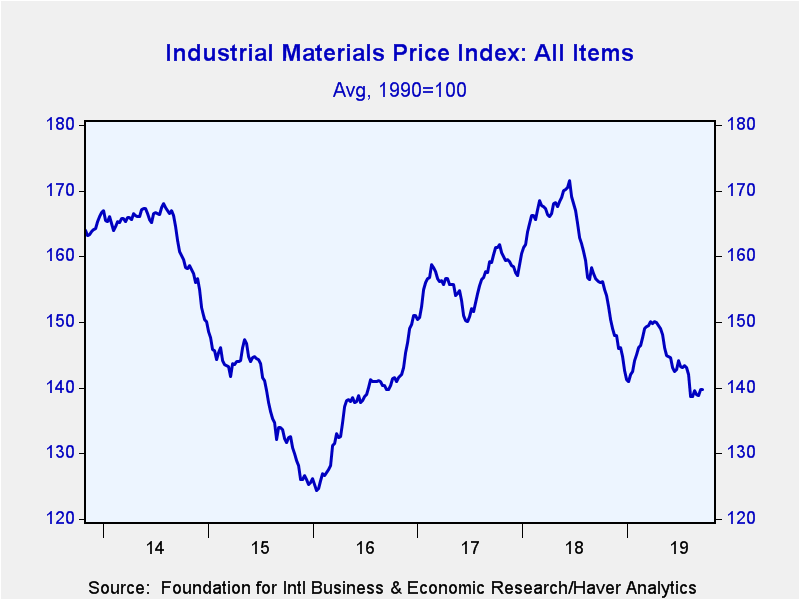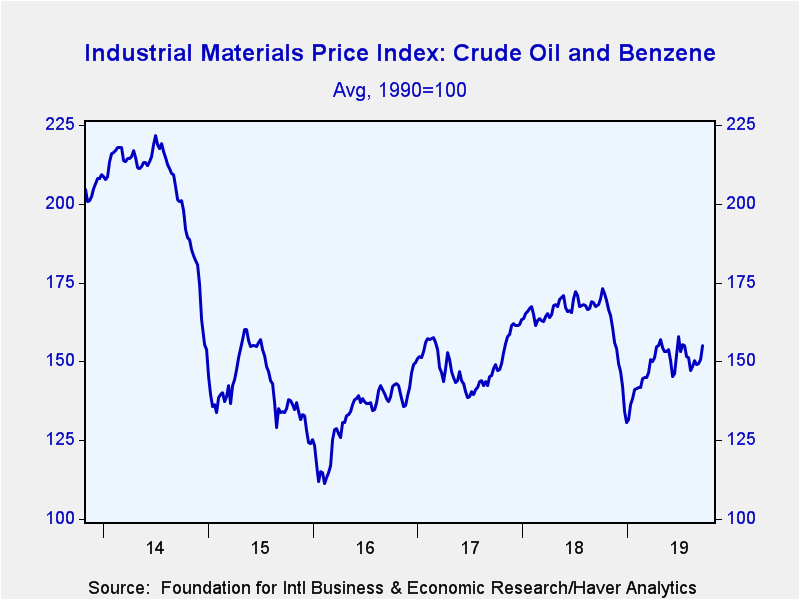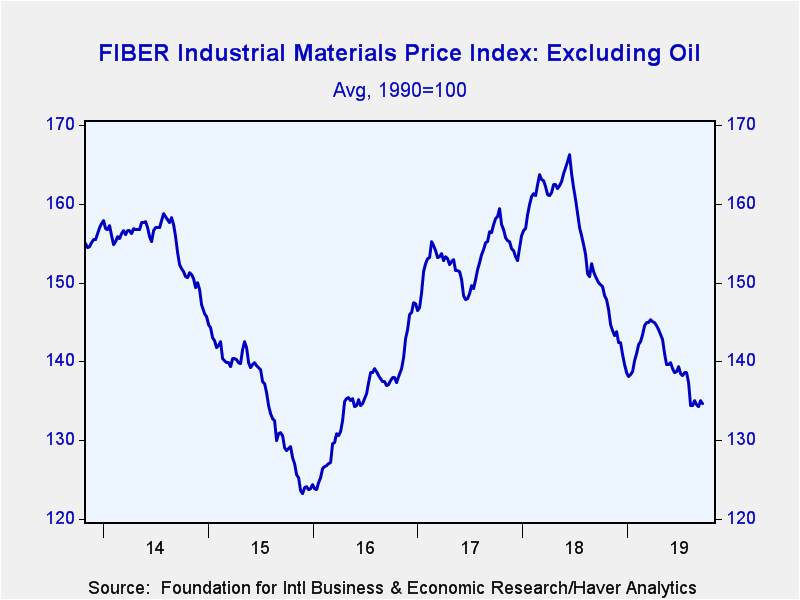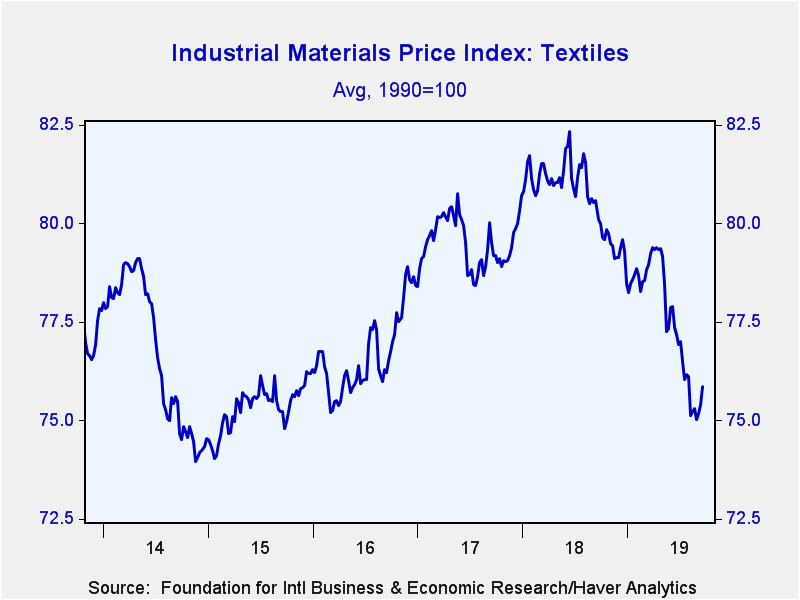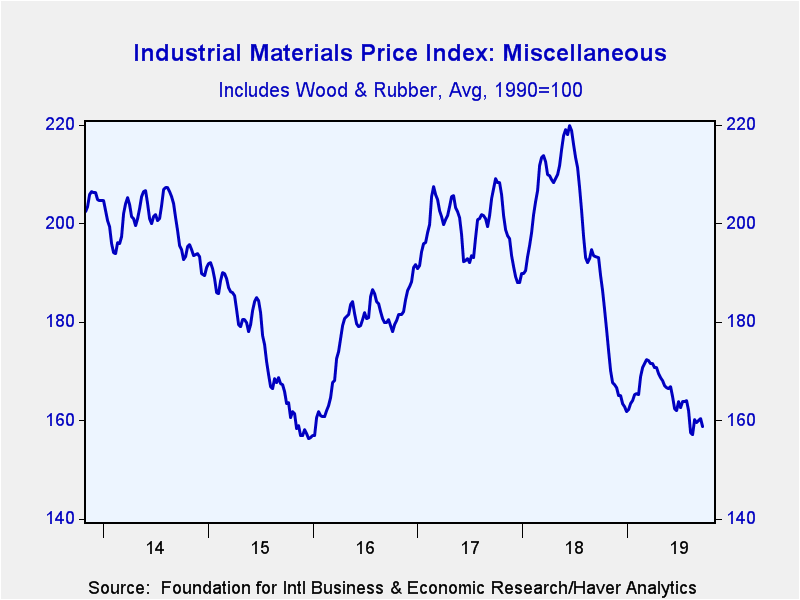 Global| Sep 20 2019
Global| Sep 20 2019FIBER: Industrial Materials Prices Stabilize
by:Tom Moeller
|in:Economy in Brief
Summary
Recent improvement in factory production has given support to industrial materials prices. The Industrial Materials Price Index from the Foundation for International Business and Economic Research (FIBER) edged 0.1% higher during the [...]
Recent improvement in factory production has given support to industrial materials prices. The Industrial Materials Price Index from the Foundation for International Business and Economic Research (FIBER) edged 0.1% higher during the last four weeks. Nevertheless, the price index remained down 10.5% y/y and neared the lowest level since June 2016.
Higher prices in the crude oil & benzene category gave the greatest support to the overall price index as crude oil prices improved 8.4% in the last four weeks. Crude oil prices rose to $60.33 per barrel last week. By yesterday, however, prices retreated and remained below the $75.05 October 2018 peak. Prices for the petro-chemical benzene improved 1.1% during the last month (-12.2% y/y). Outside of the petroleum sector, industrial materials prices eased 0.8% in the last four weeks (-17.8% y/y). Prices in the textile group increased 0.8% during the last four weeks as cotton prices surged 6.2%, though they remained roughly one-quarter lower y/y. Burlap prices declined 1.7% in the last four weeks and were off 10.0% y/y. Continuing to work lower were prices in the metals group which fell 1.1% during the last four weeks. Steel scrap prices declined 15.2%, but other metals improved. Zinc prices rose 4.5% in four weeks (-0.5% y/y) and copper scrap costs improved 1.7%. Aluminum prices edged 0.4% higher. Prices in the miscellaneous group continued under pressure and declined 0.8% during the last four weeks. Prices for random lengths of structural panel composite were off 0.9% in four weeks and by one-third y/y. Offsetting this decline was a 6.7% rise in framing lumber prices and a 0.2% improvement in the cost of natural rubber.
Lending support to prices, factory sector output rose 0.5% (-0.5% y/y) during August. Production of durable goods materials increased 0.7% (-0.1% y/y) while nondurable materials output rose 0.4% (-2.7% y/y). Following 4.0% growth last year in overall industrial output, the consensus forecast from the National Association for Business Economics (NABE) calls for a weaker 2.4% rise in industrial production during all of 2019 and a 1.8% gain next year. During the last twenty years, there has been a 56% correlation between the y/y change in industrial materials prices and the y/y change in factory materials output.
Commodity price data can be found in Haver's DAILY, WEEKLY, USECON and CMDTY databases. The NABE forecast is in the SURVEYS database.
Collateral Damage: House Prices and Consumption During the Great Recession from the Federal Reserve Bank of Philadelphia can be found here.
| FIBER Industrial Materials Price Index (%) | 1-Mth | 3-Mth | 6-Mth | 12-Mth | 2018 | 2017 | 2016 |
|---|---|---|---|---|---|---|---|
| All Items | 0.1 | -2.2 | -6.9 | -10.5 | -12.0 | 6.7 | 19.2 |
| Textiles | 0.8 | -1.7 | -4.2 | -5.3 | -2.8 | 3.0 | 2.8 |
| Cotton (cents per pound) | 6.2 | -4.4 | -18.0 | -23.6 | -9.2 | 9.8 | 10.2 |
| Metals | -1.1 | -4.8 | -17.3 | -7.7 | -12.2 | 18.6 | 32.9 |
| Aluminum ($ per metric ton) | 0.4 | 1.0 | -7.1 | -12.1 | -12.7 | 26.0 | 13.0 |
| Copper Scrap (cents per pound) | 1.7 | -0.9 | -10.5 | -3.1 | -16.1 | 29.3 | 17.3 |
| Steel Scrap ($ per ton) | -15.2 | -17.1 | -25.2 | -20.3 | 2.3 | 16.8 | 74.5 |
| Crude Oil & Benzene | 3.3 | 1.9 | 3.0 | -7.8 | -20.0 | 8.1 | 20.4 |
| Crude Oil (WTI, $ per Barrel) | 8.4 | 12.0 | 1.9 | -13.8 | -24.4 | 10.9 | 44.3 |
| Miscellaneous | -0.8 | -2.0 | -7.4 | -17.8 | -14.8 | -0.5 | 21.7 |
| Framing Lumber ($ per 1000 board ft.) | 6.7 | 12.6 | 1.4 | -16.8 | -23.1 | 20.0 | 12.9 |
| Natural Rubber (cents per pound) | 0.2 | -22.8 | -10.7 | 4.6 | -4.1 | -29.6 | 89.4 |
| All Items Excluding Petroleum | -0.8 | -2.0 | -7.4 | -17.8 | -14.8 | -0.5 | 21.7 |
Tom Moeller
AuthorMore in Author Profile »Prior to joining Haver Analytics in 2000, Mr. Moeller worked as the Economist at Chancellor Capital Management from 1985 to 1999. There, he developed comprehensive economic forecasts and interpreted economic data for equity and fixed income portfolio managers. Also at Chancellor, Mr. Moeller worked as an equity analyst and was responsible for researching and rating companies in the economically sensitive automobile and housing industries for investment in Chancellor’s equity portfolio. Prior to joining Chancellor, Mr. Moeller was an Economist at Citibank from 1979 to 1984. He also analyzed pricing behavior in the metals industry for the Council on Wage and Price Stability in Washington, D.C. In 1999, Mr. Moeller received the award for most accurate forecast from the Forecasters' Club of New York. From 1990 to 1992 he was President of the New York Association for Business Economists. Mr. Moeller earned an M.B.A. in Finance from Fordham University, where he graduated in 1987. He holds a Bachelor of Arts in Economics from George Washington University.


